 Chernobyl 2017
Chernobyl 2017 by
Blair shaw, on Flickr
It all started on the morning of 26 April 1986, at 01:23 when reactor 4 suffered a catastrophic power increase, leading to explosions in its core. This dispersed large quantities of radioactive isotopes (Iodine 131, Thorium 157 and caesium 137 among others) into the atmosphere.
Nobody knew outside the plant what had happened most of the 49,000-people living in Pripyat we fast asleep when the event took place and little did they know that in a few daysí time they were to leave their homes forever.
We travel for nearly an hour and a half on board our tour bus, nothing fancy yet adequate in fact it had 16 seats and the group of just six of us, not including tour guide Natalia and Driver Igor.
We set off for the dead zone at 0745 stopping briefly at a gas station to buy snacks and water for the onward trip, donít forget there are no stores in Chernobyl, well that are open and have items to sell anyway.
We head back onto the motorway and then sometime later we start hitting the back roads, for those who have false teeth I highly recommend super glue ! like a lot of roads in Ukraine and indeed Kiev they are not very well maintained and in our case winter tyres are a must!
After being shaken up like a martini for the best part of twenty minutes we come to the first checkpoint, now this is the entrance to the first exclusion zone the 30km one (there is two in Chernobyl a 30km and 10km depending on how radioactive each zone is) the guard is pleasant and can take a joke which was good news for my friend when I told the guard that his passport wasnít his (yes he did excrete a brick).
The barrier represents all that was wrong with the world we are entering one of the most contaminated places on earth, no one lives here full time and no one has done since 1986 and its very likely no one will do at least not for another 140 years.
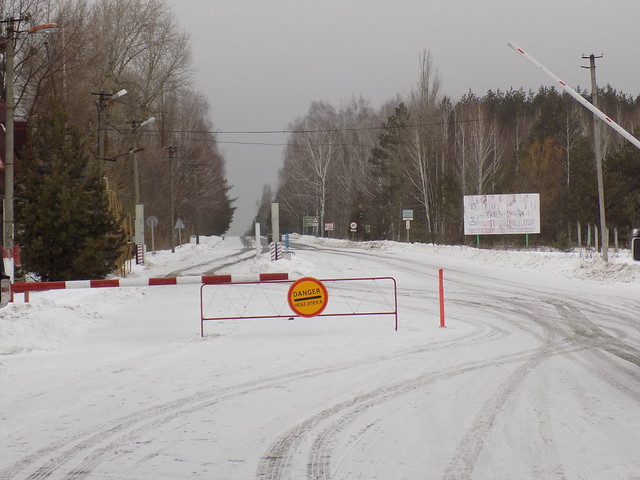 Chernobyl 2017
Chernobyl 2017 by
Blair shaw, on Flickr
We pass through the checkpoint unhindered itís become a common thing now curious tourists (like me) turning up every single day come rain or shine or in our case snow, to come and see the weird spectacle of the human races most spectacular screw up in person.
On the night 25 April 1986 no one in that control room knew that their actions would lead to the worlds worst nuclear disaster none of them knew that their actions would seal the fate of hundreds and thousands of people across the world and the effects would live on long after they and their grandchildren died.
We drive along the main road in Chernobyl passing what looks like fields with street lamps growing, Natalia informs us that these were once streets with houses and all around were other houses but because they were made of wood they were all demolished and buried now just the lamps stand as a silent monument to a village of none.
our first stop is to the village of Leliv it still stands, once home to a couple of hundred people today stands very overgrown and deserted, in fact if this was summer you wouldnít even know it was there.
 Chernobyl 2017
Chernobyl 2017 by
Blair shaw, on Flickr
Leliv is unique it is actually a big settlement and boasted a clinic itís hard to imagine now that this was once an area where babies were born.
 Chernobyl 2017
Chernobyl 2017 by
Blair shaw, on Flickr
Leliv also had its own grocery store and was a self-sufficient community many of the peoples worked on the collective farms and even had their own cattle and poultry at home, we got a chance to go inside a house something which makes you wonder if you should really be there at all.
 Chernobyl 2017
Chernobyl 2017 by
Blair shaw, on Flickr
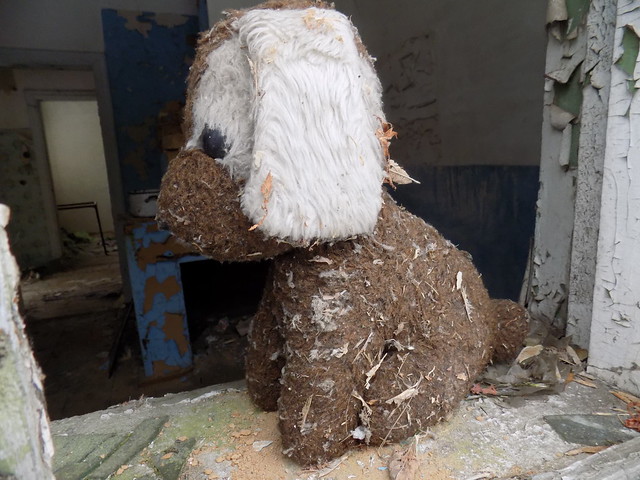 Chernobyl 2017
Chernobyl 2017 by
Blair shaw, on Flickr
 Chernobyl 2017
Chernobyl 2017 by
Blair shaw, on Flickr
Unlike stores in the west where today we can just walk in and walk out the same day with our goods a lot of the items including basic items such as sugar bread and milk basically had to be pre ordered and bought in especially for each person and in some cases they had to wait days even a week to have their order fulfilled.
In Chernobyl you donít walk much nearly everything is done by vehicle, mainly because you donít have a clue where the hot spots are and walking would take a long time due to the vast distances, the exclusion zone in Ukraine alone is 2,600km square, I hope your fit and healthy because walking that I can assure you that you wonít be.
During the night / morning of 25/26 April Chernobyl reactor 4 team were conducting a safety test something that would save power increase efficiency and make the reactor safer to operate in an emergency, still in the back of everyoneís mind was the threat of nuclear war and in that event Chernobyl was deemed a high target.
And why was that you may ask?
Not far from Leliv is a place marked on the map as ďAbandoned childrenís summer campĒ again it is a soviet cover up, in fact this place was once guarded very heavily, it was also the source of much annoyance to HAM radio enthusiasts, air traffic controllers and also basically anyone with a radio.
The site is home to Duga 1 NATO code name ďSteel yardĒ it is an over the horizon RADAR for the detection of ballistic missiles, it is so powerful the signal can and has traversed the earth full circle.
Known as the Russian woodpecker for its distinctive and annoying sound it makes over the air waves, this radar system is actually huge and is made up of 3 arrays, the system is 146 meters high and 750 meters long, today the most sensitive equipment is gone but the antenna still stands.
 Chernobyl 2017
Chernobyl 2017 by
Blair shaw, on Flickr
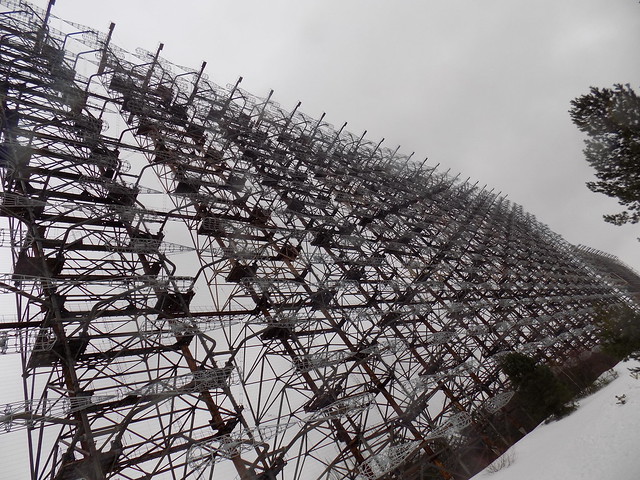 Chernobyl 2017
Chernobyl 2017 by
Blair shaw, on Flickr
 Chernobyl 2017
Chernobyl 2017 by
Blair shaw, on Flickr
The Duga 1 was built in the mid 1960ís and only became operational in 1976 known as Chernobyl 2 this site operated completely secretly right up to the day of the disaster, it has never worked since instead it has sat here for 30 years unused and it has only been since 2013 that close up tours have been allowed.
So it is back on the bus and one hell of a slippery bumpy ride to the main road, itís almost like being in a car with a world rally driver Igor seems to love getting the back end out on the bus, were now heading to a new place but this one is even more radioactive.
We are about to enter the most heavily contaminated zone the 10km exclusion zone
but just before we do we pass by the abandoned village of Kopachi we donít stop as the village was knocked down and buried much like Zalissya.
Again the checkpoint guard checks our papers itís almost like being back in the old soviet union, but this time we have to pass through a radiation check.
after all is in order we get back on the bus and to the right I notice a rather large lake, Natalia informs us that this is the cooling pond for reactors one to four and currently it is in the process of drying out.
Igor suddenly stops the bus and we are told to get out, in front of us is the abandoned building site of reactors 5 and 6 seen from the other side of the road as just a partially built cooling tower.
 Chernobyl 2017
Chernobyl 2017 by
Blair shaw, on Flickr
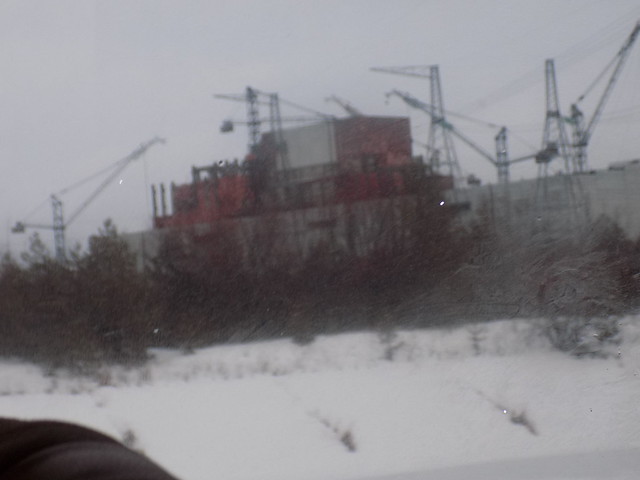 Chernobyl 2017
Chernobyl 2017 by
Blair shaw, on Flickr
then right out of the blue and in the distance there it is the entire reason I came The main plant of Chernobyl with her famous red and white chimney the old sarcophagus now under the new safe containment arch which was put in place in November 2016 the damaged reactor is entombed for the second time, even at this distance itís a sight to see and the knowledge I am heading closer to the reactor makes me even more elated.
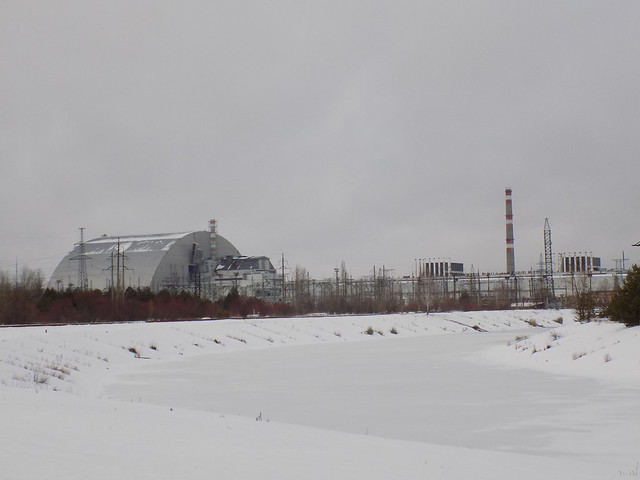 Chernobyl 2017
Chernobyl 2017 by
Blair shaw, on Flickr
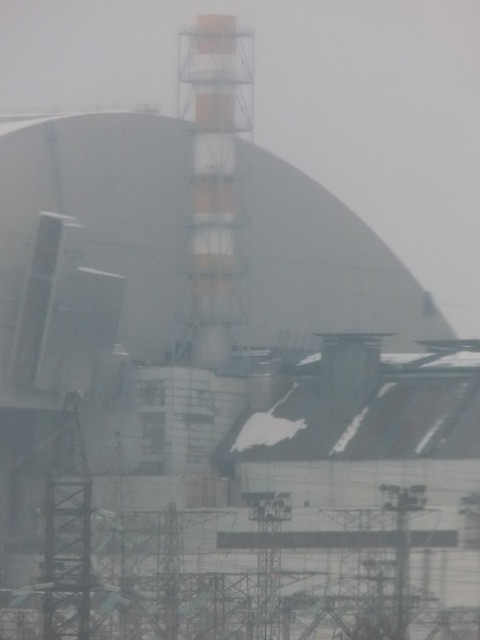 Chernobyl 2017
Chernobyl 2017 by
Blair shaw, on Flickr
The chimney once promised modern living and electricity for all, the promise of prosperity and a good life now just a relic as the country itself slips back in time.
we get back on the bus for a short trip, this time we will be staying for a while as you can imagine the Geiger counters do raise up a little around here 0.35m/s (normal background is 0.30m/s) still we are safe and safe enough that we can indeed get this close to reactor number 4 ÖÖÖÖÖ. Yep right outside.
 Chernobyl 2017
Chernobyl 2017 by
Blair shaw, on Flickr
Now obviously this is a restricted area and a restricted site so we wonít be going inside in fact the permissions to go inside have to come directly from government (letís face it I wonít be getting that any time soon)
Standing outside reactor 4 is the monument to the liquidators the men and women who helped clean the zone up after that fateful day in 1986.
 Chernobyl 2017
Chernobyl 2017 by
Blair shaw, on Flickr
outside this place is rather busy almost as if nothing has happened workers go about things just as if it were a normal day and nothing to worry about, in fact radiation levels here at reactor 4 are low they donít even set off the Geiger counters, which is good news because this is where we are having lunch with the workers.
Now far be it from me but any restaurant I have ever been in across the world including many nuclear plants in the UK Germany and France I have never had to pass through a radiation detector just to go for lunch.
 Chernobyl 2017
Chernobyl 2017 by
Blair shaw, on Flickr
Well I did and like everyone I passed ok Iím not glowing yet, although with what is on the menu today I think my last thought would be glowing more have they put the toilet seat back on the bog.
 Chernobyl 2017
Chernobyl 2017 by
Blair shaw, on Flickr
eating dinner with our comrades brings a new experience I have no idea what the drink is but I do not recommend it what so ever I also have an allergy to corn product and what looks like a pancake is actually fried chicken plus onion salad and potatoes with sweet bread (which was nice).
 Chernobyl 2017
Chernobyl 2017 by
Blair shaw, on Flickr
The atmosphere in here is rather glum every worker knows we have spent nearly their monthís salary to come here, talking to one of them they earn double the national minimum wage yet still struggle Ukraine is a very poor country and they donít even have the money to fix the bathroom let alone much else.
After dinner we head out this time to the town of Pripyat, we pass by a young wooded area to which Natalia tells us that this was once the red forest, its so called because on nights after the accident the birch trees glowed red due to the radiation, it is one of the most dangerous places in Chernobyl and no one is allowed access to it all the trees were chopped down and buried but new trees have taken their place.
Heading down the road we stop by probably the most famous road sign the sign that indicates were in the town of Pripyat.